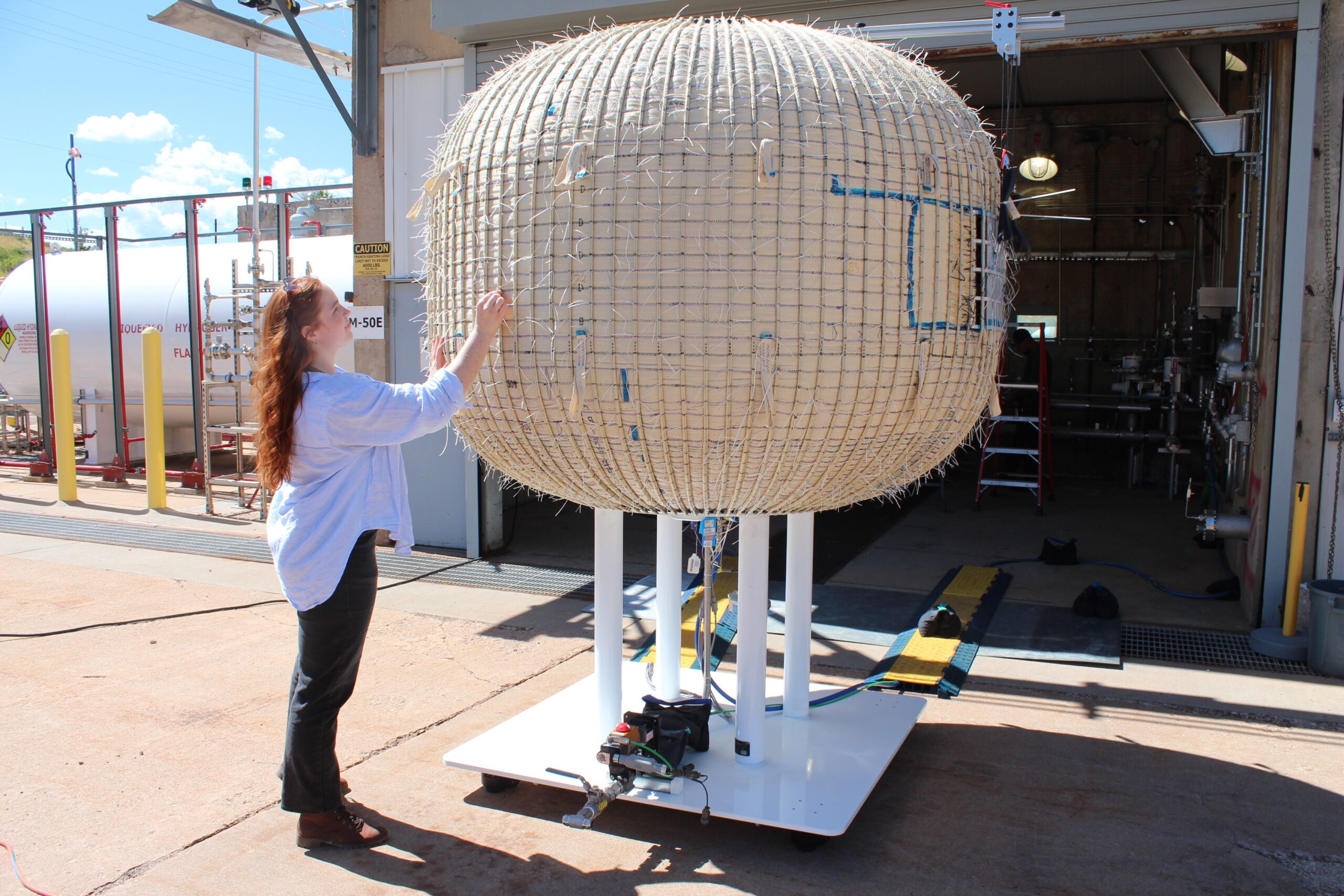LITTLETON, CO. – The common saying that “space is hard” may need redefinition, given the increasing use of softgoods to fashion inflatable structures from airlocks to habitats for future lunar and Mars missions.
Here at the Waterton Canyon facility of Lockheed Martin, the company is testing inflatable structures that offer advantages over all-metal hardware. An inflatable airlock unit underwent pressurization and depressurization appraisals on Aug. 14.
Inflatable technology is an increasingly popular idea being embraced and tested by a number of companies, including Max Space and its expandable habitat architecture. There’s also the inflatable work underway at Sierra Space on a Large Integrated Flexible Environment habitat. Sierra recently conducted a burst test of its inflatable module, announcing July 25 that the habitat withstood an air pressure exceeding that required by NASA.
One appealing aspect of inflatable space structures, explained Uy Duong, chief engineer for habitation in commercial civil space at Lockheed Martin, is that the underlying technology is highly scalable. Moreover, inflatable structures offer greater volume for less mass. That also means a larger habitable volume can be rocketed into space, packaged within the fairing of modest-sized launchers, said Rowan Palmer, a systems engineer within the Lockheed Martin Space softgoods and habitation team.
Duong added that softgoods also perform much better than metallics when it comes to protection against radiation and thermal conditions.
In the Aug. 14 test, the inflatable airlock design was put through multiple, gas-in/gas-out cycles — essentially inflations and deflations with enough nitrogen gas to pressurize the airlock to the point it becomes as rigid as steel — to assess the extent to which its Vectran material strains over time, a process called creep. Knowing how creep affects a Vectran structure will allow Lockheed Martin to properly assess its operational life potential. Test engineers here have also put subscale softgoods habitat designs to the test, purposely bursting them to spotlight their robust nature and determine their pressure thresholds.

Vectran is a high-performance liquid crystal polymer fiber that is particularly strong, rigid and stable, Duong explained. “It’s very similar to Kevlar in terms of strength, however it actually has better creep life. It can go into extreme environments much better than Kevlar,” he said.
Lockheed Martin is engaged in inflatable structure work as part of NASA’s Next Space Technologies for Exploration Partnerships (NextSTEP) program, a public-private joint venture initiative.
Safety factors
“We’re doing cyclic loading tests, pressurizing up to 14 [pounds per square inch], the operational pressure of an airlock, and then depressurizing,” said Palmer. A pressure of around 14 PSI is akin to the atmospheric pressure experienced on Earth and on the International Space Station.
That cycle is done several times, Palmer told SpaceNews, with a focus on assessing the behavior of the Vectran softgood material layers and how they meld with the inflatable structure’s metallic core as a whole system.
“NASA has a standard of four times factor of safety as a minimum for softgoods. Our burst testing proved that we will exceed that, above six times factor of safety,” Palmer said. By matching creep test data with ultimate burst pressure, the outcome yields the unit’s mission lifetime with a quantified factor of safety, she said.
“The key deliverable from any type of test like this is gathering as much data as possible,” said Palmer. During the test, internal gauges displayed critical information on pressure, the timing of particular events and the behavior of the overall structure.
Palmer declined to share certain proprietary aspects of the process for making inflatable structures.
Range of opportunities
Duong said that the new safety data will allow Lockheed Martin to test larger designs than originally planned. Those could include storage units for cryogenic fuel, pressurized tunnels to connect habitation modules and other structures to support crews on the moon and Mars. “There’s a wide range of opportunities for us to apply this technology,” he said.
Palmer said that new inflatable structures intended for space can be designed, built and tested on far shorter timescales than large metallic structures that require lengthy lead times for qualification testing. She described a “test like you fly” mindset and “a development process that allows us to move pretty fast.”
It took three months to build and prepare for testing the airlock unit and other inflatable designs, Palmer said.
Scaling up
A central reason for rapid manufacturing of inflatable units is that it’s all done on-site, said Tyler Muma, Lockheed Martin’s softgoods technology lead.
The vendor-supplied Vectran raw materials are turned into configurations in-house, allowing the company to keep a close eye on production, “so all the layering will work like a system seamlessly,” Muma said.
Specific strengths and widths of raw strap and cord utilized to fabricate inflatable units, Muma added, are done under controlled conditions, so that a repeatable, exacting result can be realized with every single build.
At the Waterton Canyon locale, smaller development units can be built, like the airlock-class structure. But Muma said that Lockheed Martin is investing in a full-scale capability to fabricate large inflatable units at NASA’s Stennis Space Center in south Mississippi.
“We’ll have more sewing machines, other equipment and a larger table that allows us to manufacture full-scale habitats. Things you would see in low Earth orbit or on the lunar surface,” Muma said.
Related
Read the original article here
